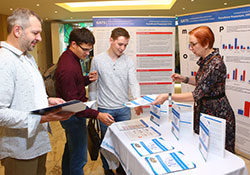New survey shows over 21% decline in tobacco use among Russian adults

Pavel Kosolapov
According to the results of the Global Adult Tobacco Survey (GATS) conducted in the Russian Federation in 2009 and again in 2016, tobacco use prevalence has decreased from 39% to 31% - representing a 21.5% relative reduction. This impressive reduction is demonstrated across both genders, with a 16% decline for males and a 34% decline for females. It is saving lives and preventing illnesses, effectively reducing the burden of noncommunicable diseases.
The GATS results were launched at the XXVII National Congress on Diseases of the Respiratory System in St. Petersburg, Russian Federation, on 17–20 October. Sergey Nikolaevich Avdeev, Chief Pulmonologist of the Ministry of Health of the Russian Federation, stated: “Every day lung specialists meet patients with chronic obstructive pulmonary disease that develops primarily as a result of smoking. We are well aware that reducing the prevalence of smoking can significantly reduce morbidity and mortality from noncommunicable diseases in the country. We therefore actively support the fight against tobacco conducted by the Government of the Russian Federation. GATS provides valuable information that will allow us to evaluate the effectiveness of the implemented tobacco control measures, adjust them and continue our work more effectively.”
At the beginning of the 21st century the Russian Federation had one of the highest smoking prevalence rates in the world, with almost 40% of the population using tobacco in one way or another. The country has strengthened tobacco control and dramatically reduced tobacco use, however, and achieved considerable progress since 2008 when it became a Party to the WHO Framework Convention on Tobacco Control (FCTC).
Higher prices and less exposure to marketing
Following a total ban on advertising, promotion and sponsorship of tobacco products, the decline in smoking is partly explained by a reduction in the proportion of the population reporting having noticed a tobacco advertisement or promotion, which went down from 68% to 23%. A further factor is a more than threefold increase in the price of the average pack of cigarettes, making them less affordable. GATS also demonstrated a reduction in exposure to second-hand smoke in homes and public places, including restaurants.
Dr Gauden Galea, Director of WHO/Europe Division of Noncommunicable Diseases and Promoting Health through the Life-course, responded to these findings, stating: “The Russian Federation has demonstrated strong leadership and made significant progress in reducing tobacco use and taking a step towards achieving the global tobacco target agreed in the Sustainable Development Goals. Full implementation of the WHO FCTC has the potential to save many more lives in the future.”
A tool for developing targeted policies
GATS is the global standard for systematically monitoring adult tobacco use and tracking progress in key areas of tobacco control. The overall response rate for the Russian GATS in 2016 was 98.2%, and a total of 11 458 individual interviews were completed. It is a powerful tool for policy-makers and enhances countries’ capacity to design, implement and evaluate tobacco control programmes. It provides a detailed description of the tobacco epidemic across age, gender, urban/rural and socioeconomic status, allowing policy-makers and programme managers to consider how tobacco-control measures can most effectively reduce inequalities. It also illustrates gaps in enforcement of the law and gives valuable information on public support for laws not yet implemented – these issues are particularly relevant to smoke-free places, advertising, the legal age to purchase tobacco products and pictorial warnings on tobacco packaging.
Funding for the GATS work was provided by the Bloomberg Initiative to Reduce Tobacco Use through the CDC Foundation with a grant from Bloomberg Philanthropies and through a voluntary contribution from the Government of the Russian Federation within the context of the WHO European Office for the Prevention and Control of Noncommunicable Diseases. Technical assistance was provided by WHO and the United States Centers for Disease Control and Prevention.



